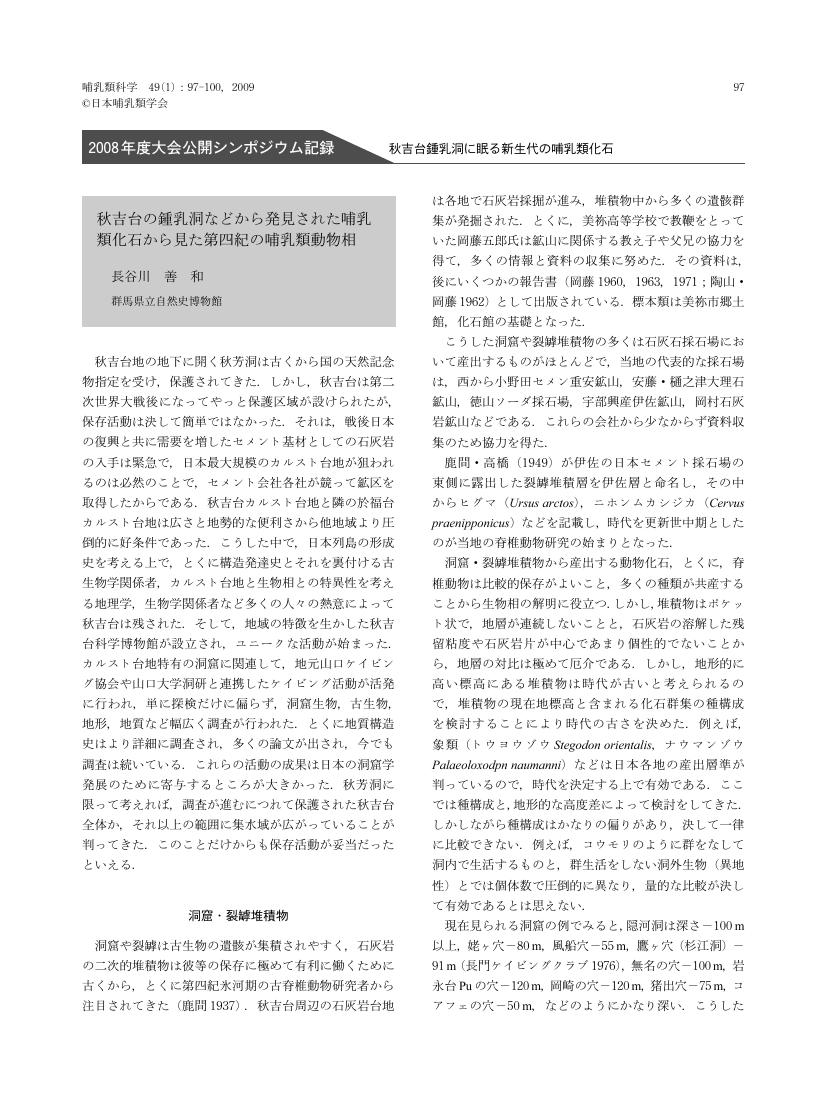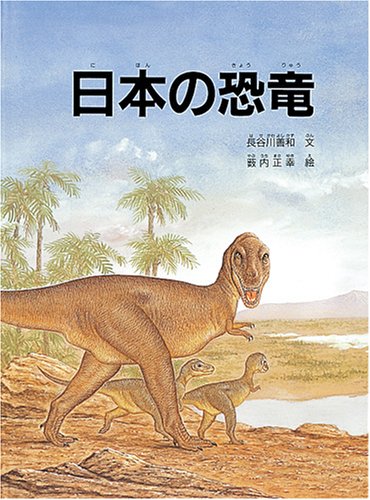19 0 0 0 OA 白亜系双葉層群より首長竜の発見
- 著者
- 小畠 郁生 長谷川 善和 鈴木 直
- 出版者
- 一般社団法人 日本地質学会
- 雑誌
- 地質学雑誌 (ISSN:00167630)
- 巻号頁・発行日
- vol.76, no.3, pp.161-164, 1970-03-25 (Released:2008-04-11)
- 参考文献数
- 8
- 被引用文献数
- 4 2
6 0 0 0 OA 白亜系双葉層群より首長竜の発見
6 0 0 0 OA 科学コミュニケーション活性化への科学と芸術の融合教育研究
- 著者
- 木村 政司 渡辺 政隆 荒俣 宏 長谷川 善和 石川 良輔 マルセル グンタート クロード クーン DR. ジョージ マクガヴァン
- 出版者
- 日本大学
- 雑誌
- 基盤研究(C)
- 巻号頁・発行日
- 2005
科学がすべての人にひらかれ、科学を「楽しむ」「伝える」「考える」「共有する」から、「関わる」「つながる」「広がる」ことへと日本の科学コミュニケーションのあり方が変化してきたことに貢献した。「科学する心」を育て、人生を豊かにする智の創造に大きく貢献し、個人の幸福を考えるだけでなく持続可能な社会の幸福を考えることができる科学の絆が、子どもたちに託せる未来を築くことが可能になる。その答えが、欧米の博物館の科学と芸術が融合した文化にあった。
3 0 0 0 恐竜"クビナガリュウ"の発掘
- 著者
- 長谷川 善和
- 出版者
- 朝日新聞社
- 雑誌
- 科学朝日 (ISSN:03684741)
- 巻号頁・発行日
- vol.30, no.4, pp.122-125,27〜29, 1970-04
3 0 0 0 OA 日本の現世哺乳類の起源を考える
- 著者
- 長谷川 善和
- 出版者
- 日本哺乳類学会
- 雑誌
- 哺乳類科学 (ISSN:0385437X)
- 巻号頁・発行日
- vol.52, no.2, pp.233-247, 2012 (Released:2013-02-06)
- 参考文献数
- 39
3 0 0 0 OA 御船層群から産出した日本で最初の肉食恐竜
- 著者
- 長谷川 善和 村田 正文 早田 幸作 真鍋 真
- 出版者
- 横浜国立大学
- 雑誌
- 横浜国立大学理科紀要. 第二類, 生物学・地学 (ISSN:05135613)
- 巻号頁・発行日
- vol.39, pp.41-49, 1992-10-30
- 被引用文献数
- 1
A tooth described herein represents the first discovery of an indisputable theropod, in Japan in 1979, which has been followed by late discoveries of dinosaurs in Kyushu and other parts of Japan. The tooth is uniquely characterised by an elongated but very thin crown, which suggests an as yet unrecognized group of theropods.
3 0 0 0 OA 九州平尾台の牡鹿洞よりかわうそが発見される
- 著者
- 長谷川 善和
- 出版者
- 日本哺乳類学会
- 雑誌
- 哺乳動物学雑誌: The Journal of the Mammalogical Society of Japan (ISSN:05460670)
- 巻号頁・発行日
- vol.2, no.3, pp.82-84, 1964-06-20 (Released:2010-08-25)
- 参考文献数
- 6
2 0 0 0 OA 日本の中部中新統産 Plotopterum (ペリカン目)の大腿骨化石
- 著者
- Olson Storrs L. 長谷川 善和
- 出版者
- 国立科学博物館
- 雑誌
- Bulletin of the National Science Museum. Series C, Geology & paleontology (ISSN:0385244X)
- 巻号頁・発行日
- vol.11, no.3, pp.137-140, 1985-09
A femur of early middle Miocene age (Hemingfordian correlative) of Honshu, Japan, that had previously been referred to the Phalacrocoracidae is here reidentified as that of a member of the Plotopteridae, an extinct family of diving birds belonging to the order Pelecaniformes. Because of the small size of the specimen it is assigned to the genus Plotopterum, heretofore known only from lower Miocene rocks of California, and it provides the youngest known occurrence of the family.
2 0 0 0 白亜系首長竜の発掘 : 産状と意義 : 古生物
- 著者
- 長谷川 善和 小畠 郁生
- 出版者
- 一般社団法人 日本地質学会
- 雑誌
- 日本地質学会学術大会講演要旨 (ISSN:13483935)
- 巻号頁・発行日
- vol.1971, 1971
2 0 0 0 OA 琉球列島の後期更新世~完新世の脊椎動物
- 著者
- 長谷川 善和
- 出版者
- 日本第四紀学会
- 雑誌
- 第四紀研究 (ISSN:04182642)
- 巻号頁・発行日
- vol.18, no.4, pp.263-267, 1980-02-29 (Released:2009-08-21)
- 参考文献数
- 21
- 被引用文献数
- 12 21
The mammalian fauna of Okinawa in the period from Late Pleistoceneto Recent is discussed. The Ryukyu Islands are known for abundant occurrence of deer fossils of Miocene type. The Yamashita-cho site of fossil man, 32, 100±1, 000y.B.P. (TK-78) in age, yields deer fossils and no other mammals. On the other hand, at the site of the Minatogawa man, 18, 250±650y.B.P. (TK-99) to 16, 600±300y.B.P. (TK-142) in age, deer fossils become few while boar fossils increase remarkably. This indicates that the Ryukyu boar gained ground taking the place of deer.Wild boars are living in such islands as Amami Oshima, Okinawa, Ishigaki and Iriomote, and many shell-mounds reveal the existence of boar. In all probability, migration of Sus must have taken place since the time of the Minatogawa man, that is, during the Würm maximum. Geologically the Ryukyu Islands are supposed to have been already separated from the continent at that time, but the occurrence of Sus suggests that the islands were partly connected with the continent even in the Würm maximum.
- 著者
- 甲能 直樹 長谷川 善和
- 出版者
- 日本古生物学会
- 雑誌
- 日本古生物学會報告・紀事 新編 (ISSN:00310204)
- 巻号頁・発行日
- no.162, pp.801-805, 1991-06-28
- 被引用文献数
- 3
埼玉県東松山市付近に分布する中部中新統神戸層下部の礫岩層より, イマゴタリア亜科に属する鰭脚類の臼歯化石が発見された。当該標本は歯冠高が低く, 歯冠の遠位舌側に極めて発達のよい歯帯を持つことなどから, セイウチ科のイマゴタリア亜科に属する鰭脚類の, 左上顎第2もしくは第3前臼歯と判断される。北太平洋沿岸域におけるこの仲間の記録としては, これまでに知られる限り最も古いものの一つとなる。当該標本は, 単離した1個の臼歯であるため属種を決定できないが, プロトコーンシェルフがよく発達していることや, 2歯根であるなど原始的特徴を保持しており, ほぼ同時代から知られているセイウチ類の祖先とされる, ネオテリウム類の臼歯に最もよく類似している。このことから, 当該標本は最古の鰭脚類であるエナリアルクトス類から, セイウチの系統に分かれた初期の仲間のひとつであったろうと思われる。
1 0 0 0 琉球列島宮古島ピンザアブ洞穴における化石ハタネズミ科臼歯について
- 著者
- 金子 之史 長谷川 善和
- 雑誌
- 日本生物地理学会会報 (ISSN:00678716)
- 巻号頁・発行日
- vol.50, no.1, pp.23-37, 1995-11-20
- 被引用文献数
- 1
1 0 0 0 沖縄県港川人遺跡の哺乳類とくに大型イノシシの形態変化について
- 著者
- 長谷川 善和 姉崎 智子 大山 盛弘 松岡 廣繁 知念 幸子
- 出版者
- 群馬県立自然史博物館
- 雑誌
- Bulletin of Gunma Museum of Natural History = 群馬県立自然史博物館研究報告 (ISSN:13424092)
- 巻号頁・発行日
- no.22, pp.23-49, 2018-03








